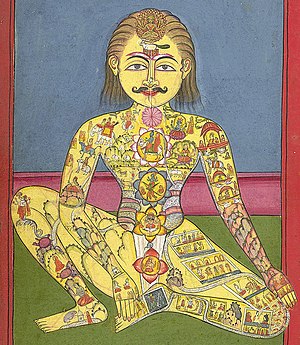Chakra are various focal points used in a variety of ancient meditation practices, collectively denominated as Tantra, or the esoteric or inner traditions of Hinduism.
The concept is found in the early traditions of Hinduism. Beliefs differ between the Indian religions, with many Buddhist texts consistently mentioning five chakras, while Hindu sources offer six or even seven. Early Sanskrit texts speak of them both as meditative visualizations combining flowers and mantras and as physical entities in the body. Some modern interpreters speak of them as complexes of electromagnetic variety, the precise degree and variety of which directly arise from a synthetic average of all positive and negative so-called "fields", thus eventuating the complex Nadi. Within kundalini yoga, the techniques of breath exercises, visualizations, mudras, bandhas, kriyas, and mantras are focused on manipulating the flow of subtle energy through chakras.
The term chakra appears to first emerge within the Hindu Vedas, though not precisely in the sense of psychic energy centers, rather as chakravartin or the king who "turns the wheel of his empire" in all directions from a center, representing his influence and power. The iconography popular in representing the Chakras, states White, trace back to the five symbols of yajna, the Vedic fire altar: "square, circle, triangle, half moon and dumpling".
The hymn 10.136 of the Rigveda mentions a renunciate yogi with a female named kunamnama. Literally, it means "she who is bent, coiled", representing both a minor goddess and one of many embedded enigmas and esoteric riddles within the Rigveda. Some scholars, such as David Gordon White and Georg Feuerstein, interpret this might be related to kundalini shakti, and an overt overture to the terms of esotericism that would later emerge in Post-Aryan Bramhanism. the Upanishad.
Breath channels (nāḍi) are mentioned in the classical Upanishads of Hinduism from the 1st millennium BCE, but not psychic-energy chakra theories. The latter, states David Gordon White, were introduced about 8th-century CE in Buddhist texts as hierarchies of inner energy centers, such as in the Hevajra Tantra and Caryāgiti. These are called by various terms such as cakka, padma (lotus) or pitha (mound). These medieval Buddhist texts mention only four chakras, while later Hindu texts such as the Kubjikāmata and Kaulajñānanirnaya expanded the list to many more.
In contrast to White, according to Georg Feuerstein, early Upanishads of Hinduism do mention cakra in the sense of "psychospiritual vortices", along with other terms found in tantra: prana or vayu (life energy) along with nadi (energy carrying arteries). According to Gavin Flood, the ancient texts do not present chakra and kundalini-style yoga theories although these words appear in the earliest Vedic literature in many contexts. The chakra in the sense of four or more vital energy centers appear in the medieval era Hindu and Buddhist texts.



